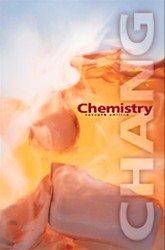 |
1 |  | 
Which of the following compounds has the lowest entropy at 25 oC? |
|  | A) | CH3OH(l) |
|  | B) | CO(g) |
|  | C) | MgCO3(s) |
|  | D) | H2O(l) |
|  | E) | H2O(g) |
 |
 |
2 |  | 
Which of the following substances has the greatest entropy per mole? |
|  | A) | O2(g) |
|  | B) | N2(g) |
|  | C) | CO(g) |
|  | D) | CO2(g) |
|  | E) | C4H10(g) |
 |
 |
3 |  | 
Without consulting entropy tables, predict the sign of DS for the following process: Pb(s) + C2(g) ----> PbCl2(s). |
|  | A) | DS < 0 |
|  | B) | DS > 0 |
|  | C) | DS = 0 |
|  | D) | More information is needed to make a reasonable prediction. |
 |
 |
4 |  | 
Using the data below, calculate DSorxn for the following reaction: 4 Cr(s) + 3 O2(g) ----> 2 Cr2O3(s).| Substance | D S, J/K·mol | | Cr(s) | 23.77 | | O2(g) | 205.138 | | Cr2O3(s) | 81.2 |
|
|  | A) | 548.1 J/K |
|  | B) | 147.7 J/K |
|  | C) | -147.7 J/K |
|  | D) | -548.1 J/K |
|  | E) | None of the above. |
 |
 |
5 |  | 
In 1774 Joseph Priestly prepared oxygen by heating mercury(II) oxide according to the reaction HgO(l) ----> Hg(l) + ½O2, for which DHo = 90.84 kJ/mol and DSo = 108 J/K.mol. Which of the following statements is true for this reaction? |
|  | A) | The reaction is spontaneous only at low temperatures. |
|  | B) | The reaction is spontaneous at all temperatures. |
|  | C) | DGo becomes less favorable as temperature increases. |
|  | D) | The reaction is spontaneous only at high temperatures. |
|  | E) | The reaction is at equilibrium at 25 oC and 1 atm pressure. |
 |
 |
6 |  | 
For the reaction H2O2(g) ----> H2O(l) + 1/2 O2(g), DHo = -106 kJ/mol; DSo = 58 J/K. Is H2O2(g) stable? |
|  | A) | No. |
|  | B) | Yes, if the temperature is low enough. |
|  | C) | Yes, if the rate of decomposition is low. |
|  | D) | Yes, if the O-O bond energy is greater than the O-H bond energy. |
|  | E) | Yes, under all conditions. |
 |
 |
7 |  | 
The signs of DHo, DSo, DGo for the vaporization of water at 50 oC are |
|  | A) | positive, positive, and positive. |
|  | B) | negative, negative, and negative. |
|  | C) | positive, negative, and positive. |
|  | D) | positive, positive, and negative. |
|  | E) | More information would have to be given to answer the question. |
 |
 |
8 |  | 
Use the following data to calculate DGo at 298 K for the combustion of propane:
C3H8(g) + 5 O2(g) ----> 3 CO2(g) + 4 H2O(l)| Substance | D Gof, kJ/mol | | C3H8(g) | -23.0 | | O2(g) | 0 | | CO2(g) | -394.6 | | H2O(l) | -237.2 |
|
|  | A) | 2109.6 kJ/mol |
|  | B) | 608.8 kJ/mol |
|  | C) | -608.8 kJ/mol |
|  | D) | -2109.6 kJ/mol |
|  | E) | None of the above. |
 |
 |
9 |  | 
The heat of vaporization of 1-pentanol is 55.5 kJ/mol, and its entropy of vaporization is 148 J/K.mol. What is the approximate boiling point of 1-pentanol? |
|  | A) | 100 oC |
|  | B) | 375 oC |
|  | C) | 0 oC |
|  | D) | 25 oC |
 |
 |
10 |  | 
Calculate DGo for the dissociation of HF in H2O at 25 oC. [Ka of HF = 6.9 x 10-4 at 25 oC]. |
|  | A) | -18 kJ |
|  | B) | 7.83 kJ |
|  | C) | -7.83 |
|  | D) | 1.51 kJ |
|  | E) | 18 kJ |
 |



 2002 McGraw-Hill Higher Education
2002 McGraw-Hill Higher Education